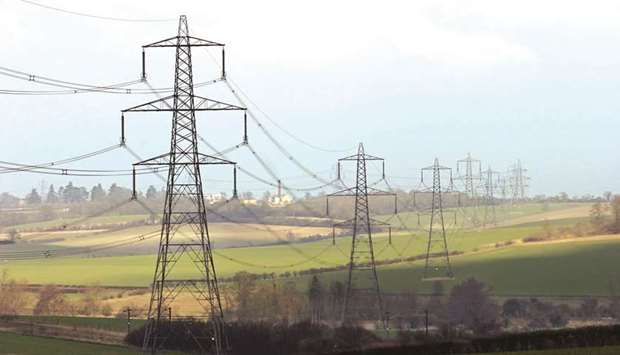An iPhone app with a real-time weather feed sees it’s overcast again, so it tells the diodes embedded in the bedroom walls to mimic sunrise. As the light brightens, the shower tap opens and the water reaches the desired warmth just as the first whiff of espresso wafts in from the kitchen down the hall.
The device is guiding not only how the power is being used, but also where and how it’s being generated. Since it’s gusty in Scotland, this morning’s supply is coming from tethered drones that turn wind into electricity and send it down a patchwork of interconnected local grids that can operate outside the old network with the swipe of a finger. The forecast is for calm up north, so solar panels down south in Spain will pick up the slack in the afternoon.
The best part is the bill, which greater competition and efficiency has driven down to just £5 a month, wired automatically to a Google unit that aggregates and distributes power based on algorithms that learn from inputs like targeted usage and tolerance for non-renewable sources. A Tesla Inc battery tucked in a closet and fed by a photovoltaic module on the balcony kicks in when fully charged, providing self-sufficiency for days at a time.
Fully “smart” systems that optimise each stage of the process are evolving the world over, but nowhere are utilities embracing the transition more urgently than in Europe, where political leaders and regulators view man-made climate change as settled science. Beyond the environment, at stake is the fate of an industry that’s rushing to shed an outdated business model and fend off deep-pocketed disrupters like Google and Amazon.com, as well as upstarts anxious to capitalise on a new generation of ecologically conscientious consumer.
“The conventional utility model is dying,” says Peter Terium, chief executive officer of Innogy, a unit of Essen, Germany-based RWE. “If you don’t adapt now, it’s hard to see how you’re going to survive.”
RWE is one of two major European utilities to separate its traditional, commodities-based business from its renewables or network businesses in the past 18 months. In both cases the more technology-focused company immediately became more valuable. Innogy’s market value, about €19bn ($21.6bn), is almost double RWE’s, while EON is worth almost triple its new Uniper unit, which represents the German utility’s conventional coal, natural gas generation and commodities trading business.
In part it’s a bet on the view that in the future, as the proliferation of renewables and technology makes it possible to produce power on a smaller, cleaner scale, the money won’t be in big power plants anymore. The future of energy will look more like customer-focused data management, an area where tech companies already excel.
The trend was reflected in a global survey of industry executives that PriceWaterHouseCoopers conducted two years ago, when more than half said they wouldn’t rule out descending into a corporate “death spiral.”
Though they’ve diversified into other areas, most integrated utilities still get a large part of their revenues by burning fossil fuels at massive power plants and selling the energy, iterations of Thomas Edison-built stations that first came online in the 19th century. But between now and 2040, 72% of the $10.2tn the world will spend to add capacity will go toward doubling renewables’ share of the mix to about one-third, Bloomberg New Energy Finance estimates in an outlook published last week.
Driving the change are millennials, a generation of people who reached adulthood in the early 21st century and are demanding both cleaner energy and better ways to use it.
For EON, venture capitalism is a way forward. The company, which like RWE is based in Essen, was an early investor in Thermondo, a Berlin start-up that bills itself as hastening the switch to a newer, more decentralised energy system with lower carbon emissions. Thermondo, which started as an online boiler brokerage, has since expanded into solar, fuel cells and will offer home batteries in the future. It now has 150 workers and has served 6,000 customers.
As carbon-free generation increases and companies like Tesla and Daimler AG improve battery storage and efficiency, micro-grids are starting to eat away at the old utility model. By 2040, half of Europe’s electricity supply will come from variable renewables, BNEF estimates show. Decentralised energy, the kind that weakens demand for big power plants, will account for a third of the capacity in Germany by the same year, the outlook shows.
Technology is also winning government support. At one of Britain’s latest power auctions, a held to prevent electricity blackouts, a record 2.7% of new capacity was awarded to tech companies. What Boston-based EnerNOC and other winners offered was software that finds more efficient ways to turn off or delay extraneous power usage.
One millennial, 27-year-old Simon Phelan, quit his job at Jon Moulton’s Better Capital PCC in London to start his own version of Thermondo called Hometree Marketplace.
Hometree, which raised £2.5mn from Moulton and other investors, declined investment offers from five major European utilities, Phelan said, without naming them.
He has already convinced fellow millennial Ed Ward, who turned to Hometree out of frustration with his longtime provider, British Gas.
“BG was trying to give me a boiler that was too massive, as if I wanted to add a million stories to my house,” Ward said. “Why would I need that?”

